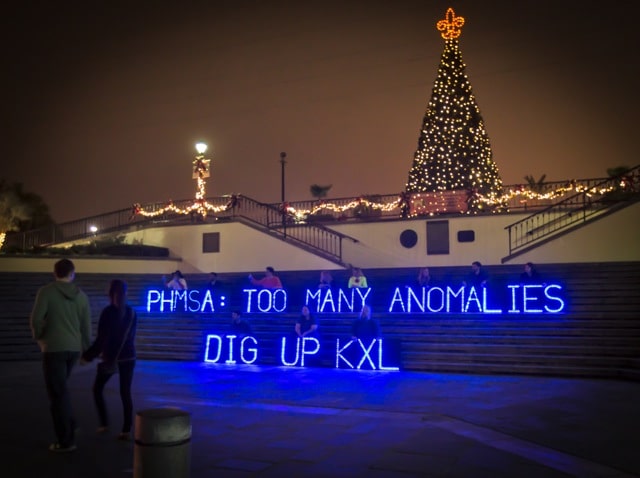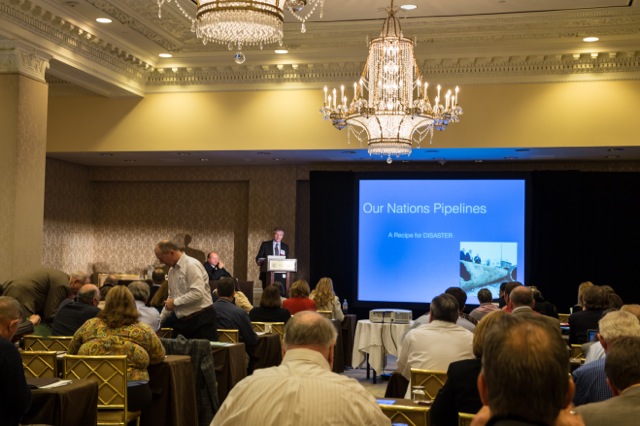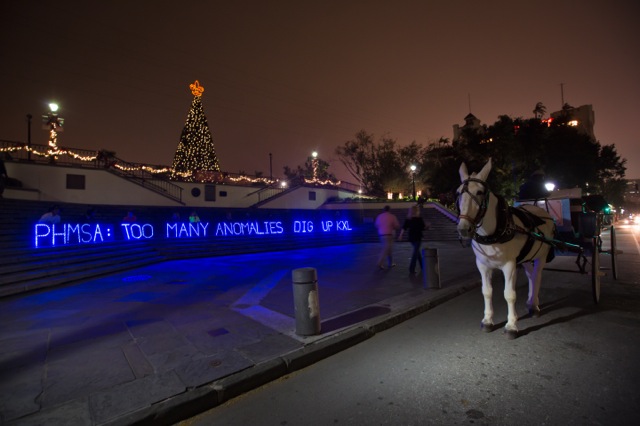A federal pipeline safety official admitted on camera recently that he made a point of ensuring his home wasn’t in the path of any pipelines before buying it, and that he wouldn’t advise anyone to build in the path of a pipeline.
The official, Bill Lowry, is responsible for community assistance and technical services for the southwest region of the Pipeline and Hazardous Materials Safety Administration (PHMSA).
At a Public Safety Trust conference on Nov. 21, Lowry was asked, “Knowing what you know about the problems in the Keystone XL‘s construction, what would you do if your house was in its path?”
His answer: “Here is what I did when I bought my house — I looked on all the maps, I looked for all the well holes. I found there is nothing around me but dry holes and no pipelines. And it’s not because I’m afraid of pipelines, it’s not because I think something will happen. It’s because something could happen. … You’re always better off, if you have a choice….”
He trailed off before finishing his sentence, but added that, “If I was building a house, I wouldn’t build it on a refinery, … I wouldn’t build it on a pipeline, because they’re all industrial facilities. That’s just the reality.”
Watch video of PHMSA’s Bill Lowry explaining what measures he took to keep his own family safe from pipelines, and the “reality” of pipeline risks:
“Lowry’s answer was not terribly reassuring to those along the Keystone XL route, inferring they should have done their due diligence before settling in,” said Ramsey Sprague, spokesperson for the Tar Sands Blockade. “Lowry expects the public to trust that regulators will keep them safe, although he himself doesn’t trust it enough to buy property near a pipeline.”
TransCanada’s Keystone 1 pipeline had 14 leaks in its first two years of operation and the southern route of Keystone XL has suffered a rash of anomalies caused by construction code violations documented in a report by the advocacy group Public Citizen. CBS News confirmed construction violations in an investigative report. President Obama’s decision on the northern route is expected in early 2014.
Public Employees for Environmental Responsibility (PEER) released a report in October pointing out that PHMSA spends more time at industry conferences than on-site at incidents. Jeffery Wiese, an associate PHMSA administrator, countered the report with a letter stating PEER misinterpreted data. However PEER‘s report raises legitimate concerns about PHMSA‘s attendance at such events, given that PHMSA‘s own representatives are quick to point out their staff are stretched thin in their attempt to regulate the vast pipeline network in the United States — a network that is continually growing, while the number of regulators stays the same.
Carl Weimer, Executive Director of the Public Safety Trust speaking in New Orleans ©Julie Dermansky
Members of the Tar Sands Blockade confronted PHMSA with their concerns about Public Citizen’s damning report calling for new hydrostatic testing of the southern route of the Keystone XL. They questioned Lowry about what was being done to ensure the pipeline’s integrity in light of the high number of repairs made before the pipeline was even put into use.
Lowry told them he was pretty sure TransCanada was required to do some kind of additional testing after fixing all the anomalies, but was unsure of what kind. However, on June 17th, TransCanada’s spokesman Shawn Howard confirmed in an email a new hydrostatic test is not required after the anomalies are fixed. Howard explained,
“All replacement pipe sections are pre-hydrotested in the same manner as the pipeline prior to installation. The final tie-in welds are tested using radiation technology in combination with ultrasonic technology. The welds are subject to an approximately 24 hour delay prior to non-destructive examination being performed. The pipeline is then re-inspected on an inspection frequency of every 3-5 years during.”
Tar Sands Blockade hold up a message for PHMSA in New Orleans French Quarter ©2013 Julie Dermansky
When asked if the same company that created the problems should be trusted to do the repairs, Lowry said, “I don’t know if they should be trusted, but there is a certain level of oversight we are funded for.” When asked how many inspections were done while the repairs were being made, Lowry replied, “For any thumbs up or thumbs down questions you need to file a Freedom of Information Act (request).”
Despite two warning letters sent by PHMSA to TransCanada on September 10th and 26th, TransCanada intends to put the southern end of the pipeline into operation by the end of the year. The letters cite TransCanada for not following construction specifications, which led to anomalies, and point to TransCanada’s alarming welding record. Of the 205 welds in a single section of the pipeline, 50 percent have failed.
Similar warning letters were sent by PHMSA to TransCanada about the Bison pipeline in 2011. The Bison Pipeline ruptured six months after it was put into service in Wyoming. In both cases, PHMSA chose not to fine TransCanada, nor did they enforce remedial actions to ensure the pipeline’s integrity.
When asked, PHMSA‘s Community Assistance & Technical Services managers Bill Lowry and Harold Winnie won’t discuss PHMSA’s regulatory power:
PHMSA‘s mandate is to keep the public safe. The agency can fine companies that are not in code compliance and even recommend the companies be prosecuted. The question is: if the agency has the teeth to protect the public, why isn’t it using them?
Subscribe to our newsletter
Stay up to date with DeSmog news and alerts








